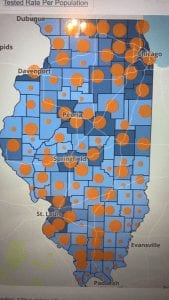If The Quad-Cities, And The U.S., Wants Full Covid Recovery, Now’s The Time To Take Action
Some call me a pessimist.
Some call me a cynic.
Some call me the space cowboy, some call me the gangster of love.
I prefer to think of myself as, no, not Maurice, but, rather, a pragmatist.
A realist.
And realistically, I don’t see the next few months going well in terms of covid-19.

Iowa Gov. Kim Reynolds
Today, Kim Reynolds is going to talk about potentially pulling back restrictions she put in place a month ago in regard to the pandemic ripping its way through the Midwest, and especially Iowa.
Many think she’s going to pull back the restrictions.
I don’t think she should.
I know everyone wants to get back to normal and wants everything to be fantastic again, as if nothing ever happened, and believe me, so do I, but I don’t see it happening for a while.
That’s not based on wanton negativity, it’s based on data, facts and extrapolation of both.
Covid numbers throughout the United States are insane and we as a country have just become numb and dumb to them to dull the impact. Among the top 10 days marking the one-day greatest losses of life in the history of this country, the majority of them are deaths due to covid.
Since Iowa and Illinois went to mitigation measures, Iowa on Nov. 17, and Illinois on Nov. 20, the numbers in both states have slowly sloped downwards.
In Illinois, Governor JB Pritzker is seeing that as a positive sign that the mitigations he put into place are working, and in response to the fact that numbers everywhere are still substantial, he’s keeping them in place. People may not like it, but from a logical perspective, it’s the right thing to do. He’s found something that’s working at keeping them at bay and actually reducing cases during a time of soaring infections, and so he’s continuing on the path to keep those numbers hopefully at bay and continuing to go down.
Iowa’s Kim Reynolds is another story. Iowa’s mitigations as they stand aren’t as restrictive as Illinois, and the number of infections and deaths in Iowa reflects the fact that Iowa has long been slow to come up with mitigations. Like Illinois, since their mitigations have been put into place, the number has been sloping downwards, but that doesn’t change the fact that Iowa’s number of infections has been consistently three times or more larger than Illinois’ number, despite Illinois having roughly four times the population of Iowa. The death tolls are usually roughly the same in terms of daily numbers, which, again, does not look well for Iowa given that their population number is far lower than Illinois and their population density is nowhere near as high.

JB Pritzker at his press conference yesterday.
Reynolds announced last week that she’s slowly easing up on mitigations and looking at scaling them back as soon as today. If she does, expect it to be a disaster, because without mitigations put forth in some form, regardless of state, the upcoming months are going to be a mess.
Right now we’re starting to see increasing numbers due to the huge number of people who didn’t pay attention to mitigations and the common sense requests in place – masks, social distancing, stay at home if you can, etc. – during the Thanksgiving holiday.
If you think that’s bad, just wait.
In less than ten days, we see Christmas, and within this time are a number of other religious and secular holidays as well, offering people the opportunity to get together.
Then there’s New Year’s Eve, which is going to invite a number of parties and huge gatherings into the mix.
It usually takes 2-3 weeks for infection numbers to spike after these types of gatherings. Well, 2-3 weeks after Thanksgiving takes us to mid-December. Then 2-3 weeks after the Christmas and New Year’s Week takes us into mid-January.
Then there’s a brief respite and Valentine’s Day pops up, which again invites people to disregard any protocols.
Take that out 2-3 weeks and we’re into March.
Then mid-March is another big drinking and social gathering holiday, St. Patrick’s Day. Not to mention spring break for various colleges going on throughout March.
Take that out two weeks, and there’s April.
And right there on April 4 is Easter.
So throw another couple of weeks on there after people disregard protocols for Easter, and we’re in mid-late April.
Almost May.
Four months from now.
All the sudden, we’re here in mid-December, looking at another four-five months of dealing with this.
We’re looking at four-five months of people getting sick, people who had previously blown it off realizing it’s not a whole lot of fun to get it, people filling up hospitals, people dying.
And people dying because of all the covid patients in the hospitals.
That’s one of the things that gets consistently overlooked in this.
 Sure, the mortality rate is relatively low. Sure, the majority of the people dying are older. But those folks deserve medical care too. Those folks don’t deserve to be left to die. And when they come to a hospital, they’re going to get that care, and need to take up a hospital bed to get it.
Sure, the mortality rate is relatively low. Sure, the majority of the people dying are older. But those folks deserve medical care too. Those folks don’t deserve to be left to die. And when they come to a hospital, they’re going to get that care, and need to take up a hospital bed to get it.
Now, when they take up that hospital bed, that’s one less hospital bed open for other treatable health matters that are in urgent need of medical care. Heart attacks. Strokes. Car accidents. Various other maladies that need ICU and ER care. What happens if covid patients are taking up all the beds and there’s a flurry of people coming in from an accident? What if there are beds being taken up by people with other injuries or maladies and suddenly there’s a covid surge, where do those covid patients go, especially if they are older?
Those are the things that doctors and nurses keep telling me when I interview them about this. It’s not just covid, it’s the domino effect of covid that’s causing a crisis within the hospitals, and the fact that people are disregarding that factor.
And that’s not even taking into account the other factors of covid: People being out of work, businesses shuttering their doors temporarily, businesses shutting their doors permanently, kids being out of school and experiencing another epidemic of academic failures which is being documented across the country. How many kids who are already academically or socially challenged are being pushed even further behind by this? How many people in poverty are being shoved down deeper into a hole by it?
It’s tough to say this could’ve all been prevented, because it’s impossible to predict a virus. We live in a vast country and odds are there was always going to be a virulent spread.

Illinois, including both sides of the Quad-Cities, remains a covid-19 hot spot.
However, it could’ve, and should’ve, been better. It could’ve, and should’ve, been handled better. By those in authority, and the general population. It wasn’t. It hasn’t been.
But it still could be.
People have had the time to see what’s going on. People have had the opportunity to get the facts. People have had the opportunity to experience the impact themselves. And hopefully, people have changed their opinions and become more careful and smart about this.
It’s really not that big of a sacrifice to wear a mask. It’s really not that big of a deal to socially distance. To cut down on your social exposure. To be smart about your interactions. And, here’s something that rarely gets mentioned but should more often: To take proven measures to strengthen your immune system to make it more difficult for you to get and spread the virus.
We’ve got an opportunity here to turn things around. Yes, the first round of the vaccine is here, being given first to health care providers, as it should be. But it’s going to take a while for it to get out into the general public. And even when it does, only half of the people in the U.S. are saying they’ll definitely take it, and a full quarter of the population is saying that they definitely won’t.
We’re still in for a bumpy ride for a while here. But it can be better if we can all learn from the mistakes of the past year and build upon the successes.
I hope that the numbers get better. I hope that the mitigations work. I hope that people follow the mitigations and do the right things, and they’re as sick of all this crap as I am, and decide to hell with it, let’s buckle down and make the sacrifices and mask up, social distance, chill on the big gatherings, and get this done, and get beyond this so that we can get our normal lives back.
But will that happen?
Or will the next four to five months play out like a roller coaster, with a series of dips rolling up fast into spikes following all the holidays coming up, and people continuing to disregard mitigation measures?
What do you think?











